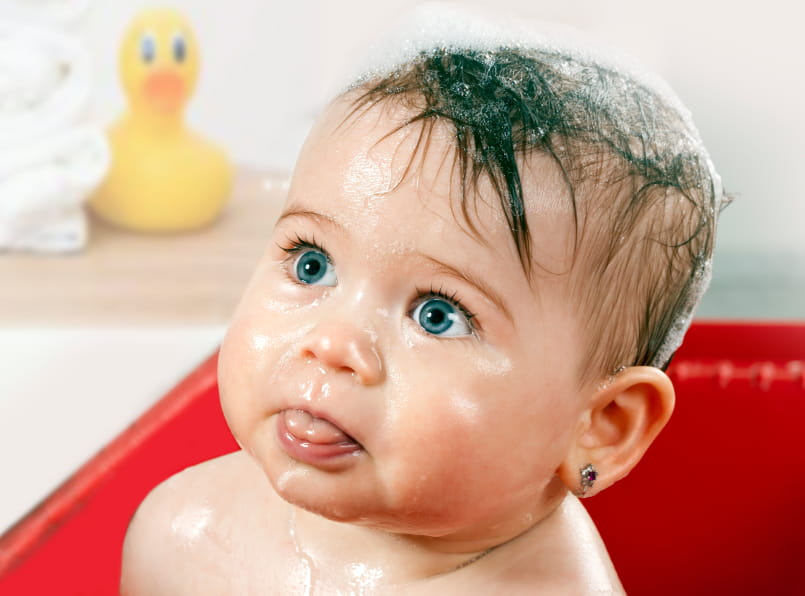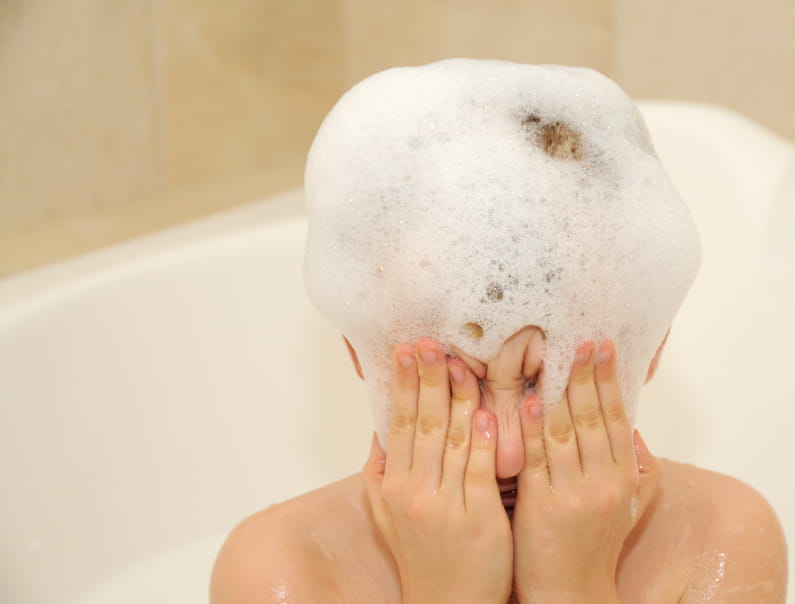The Baby Drank Shampoo Prevention and Treatment

The Bottom Line
Shampoos contain ingredients ranging from detergents to conditioners to vitamins, botanicals, to beer. Some are formulated to be mild enough for babies. Some contain medically active ingredients. Shampoo is a minimally toxic product when used on the hair and scalp but can cause symptoms if swallowed or splashed in the eye.

The Full Story
Non-medicated shampoos
Modern shampoo was developed in the 1930s and contains detergents (also called surfactants, short for "surface active agent") instead of the harsh soaps used in earlier times. Shampoos primarily clean the hair and scalp of sebum (the oily secretion of the sebaceous glands), perspiration, skin scales, residue of previously used hair care products, and environmental pollutants. In general, these products have low toxicity but they can occasionally be dangerous.
Non-medicated shampoos often contain a mixture of surfactants. There are five categories of shampoo detergents: anionic, cationic, non-ionic, amphoteric, and natural. Each has different hair cleansing and conditioning properties.
Anionic surfactants are among the most popular in shampoos. You might recognize the terms lauryl sulfate or laureth sulfate from your shampoo label. These are rather harsh detergents that lather and rinse well. Shampoos with lauryl sulfates are commonly used for oily hair. Those with laureth sulfates also have good lathering and rinsing properties for use in cleaning normal to dry hair.
Sarcosines are other detergents in the anionic class, such as lauryl sarcosine. These are listed second or third on some shampoo labels. They don't remove sebum well but function as good conditioners. Lastly, the anionic class of detergents includes sulfosuccinates, such as disodium oleaminesulfosuccinate, strong detergents used as secondary surfactants in shampoos for oily hair.
Shampoos containing cationic detergents, such as cetyltrimethylammonium chloride, in contrast, do not lather well and are poor cleansers but give softness to the hair and are used in shampoos for permanently colored, bleached, or chemically-damaged hair.
Non-ionic detergents such as polyoxyethylene sorbitol esters, are very mild cleansers and provide good anti-static qualities.
Amphoteric detergents are used in baby shampoo because they don’t cause as much eye stinging, lather well, and leave the hair soft. Examples of amphoteric detergents that you might see in baby shampoos include cocamidopropyl betaine and sodium lauraminopropionate.
Natural detergents traditionally were derived from Sapindus shrubs or trees, commonly known as soapnuts or soapberries, and contain natural surfactants called saponins. These were used for hair cleansing in ancient India. In fact, the term shampoo entered the English language through the Hindi word "champoo," meaning to press or massage. There has been a recent revival in the use of plant-based hair care products. These natural surfactants may come from plants such as sarsaparilla, soapwort, soap bark, or ivy agave. They lather well but have poor cleaning properties and are often added for marketing purposes to attract those seeking a natural alternative to synthetic shampoo detergents.
What about beer? It's certainly natural. Beer is an ingredient in some commercial shampoos, and some people make their own beer-containing shampoo. Two of the basic ingredients in beer - malt and hops - are high in protein, which can act as nourishing and strengthening agents.
The effectiveness of vitamins, most commonly vitamin E, added to shampoos is debatable. They are probably not in high enough concentrations or in contact with the hair or scalp long enough to be of benefit.
The many detergents in shampoos have long chemical names and there is much speculative information, especially on the internet, that such detergents and other common shampoo ingredients might cause cancer, negatively affect the immune system, or precipitate an allergic response. However, except for allergy or hypersensitivity potential, there is little science-based evidence that these ingredients are likely to be carcinogens or otherwise cause health problems.
Medicated shampoos
Medicated shampoos are used to treat scalp problems such as seborrheic dermatitis, psoriasis, and bacterial or fungal infections. In addition to regular cleansers, they contain active agents such coal tar, selenium sulfide, or zinc pyrithione.
Coal tar (a byproduct of coal production) shampoo can be used to treat dandruff, psoriasis, and seborrhea (oily, crusting, or scaling skin). It works by slowing bacterial growth and loosening and softening scales and crust. It can cause mild stinging of the scalp or skin irritation.
Selenium sulfide, an anti-infective agent, relieves itching and flaking of the scalp and removes the dry, scaly particles that are commonly referred to as dandruff. There have been reports of orange scalp discoloration in a few children treated with selenium sulfide shampoo. The coloration was easily removed with rubbing alcohol.
Zinc pyrithione is an antiseborrheic. It works by slowing the production of skin cells, which helps to reduce flakiness. It is used to treat and prevent itching, flaking, and scaling of the scalp caused by dandruff or seborrhea. It can cause skin irritation. One report described a 35-year-old woman who had a 5-year history of stable psoriasis and no other skin disease. She had used many antidandruff shampoos. She was then treated with a new shampoo containing zinc pyrithione. Within 1 week she developed severe pustular psoriasis with many lesions in the area where the shampoo was applied. Skin patch testing showed an allergic contact dermatitis reaction to zinc pyrithione.
If shampoo is swallowed or gets in the eyes
When shampoo is swallowed in small quantities, mild nausea, vomiting, and diarrhea can occur. Usually the only treatment needed is drinking fluids or sucking on ice chips. If gastrointestinal symptoms are severe or persistent, Poison Control could have additional recommendations.
When shampoo gets in the eyes, irritation and redness are common. Serious eye injury is not likely. The eyes should be rinsed immediately. Remove contact lenses. Use lots of room temperature water. For children, pour water onto the bridge of the nose and let it gently run into the eyes. Encourage blinking. Then check with Poison Control after rinsing.
Baby shampoos often contain detergents that numb eye tissues to prevent stinging. However, baby shampoo can still potentially irritate the eyes.
If you suspect someone has swallowed shampoo or got it in his eyes, immediately check the webPOISONCONTROL® online tool for guidance or call Poison Control at 1-800-222-1222.
Mary Elizabeth May, RN, BA, MPH
Certified Specialist in Poison Information
Poisoned?
Call 1-800-222-1222 or
Prevention Tips
- Keep shampoo in its original container.
- Carefully read and follow directions on the shampoo label.
- Unless you have a scalp condition, use non-medicated shampoo products.
This Really Happened
Case 1. A 30-year-old woman got non-medicated conditioning shampoo in her eye. She called Poison Control complaining of burning in the eye. Following the advice given by Poison Control, she flushed her eye well in the shower and within 2 hours her eye irritation was gone.
Case 2. While washing his hair with a selenium-containing dandruff shampoo, a 40-year-old man unintentionally swallowed some shampoo. He vomited three times. He also complained of mouth irritation. His wife called Poison Control, which recommended sips of fluids, ice chips, and an antacid. Within a few hours, all of his symptoms had resolved.
Case 3. A 9-year-old girl unintentionally swallowed a little dandruff shampoo containing zinc pyrithione while washing her hair. She complained of throat burning and her mom called Poison Control, which recommended a cold and creamy snack. The child’s mother followed this advice and the throat irritation resolved quickly.
For More Information
How to Handle Dandruff [Internet]. 2015 Mar 13 [accessed 2016 Mar 8].References
Poisoned?
Call 1-800-222-1222 or
Prevention Tips
- Keep shampoo in its original container.
- Carefully read and follow directions on the shampoo label.
- Unless you have a scalp condition, use non-medicated shampoo products.
This Really Happened
Case 1. A 30-year-old woman got non-medicated conditioning shampoo in her eye. She called Poison Control complaining of burning in the eye. Following the advice given by Poison Control, she flushed her eye well in the shower and within 2 hours her eye irritation was gone.
Case 2. While washing his hair with a selenium-containing dandruff shampoo, a 40-year-old man unintentionally swallowed some shampoo. He vomited three times. He also complained of mouth irritation. His wife called Poison Control, which recommended sips of fluids, ice chips, and an antacid. Within a few hours, all of his symptoms had resolved.
Case 3. A 9-year-old girl unintentionally swallowed a little dandruff shampoo containing zinc pyrithione while washing her hair. She complained of throat burning and her mom called Poison Control, which recommended a cold and creamy snack. The child’s mother followed this advice and the throat irritation resolved quickly.
